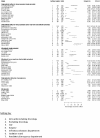Adverse drug reactions in children--a systematic review
- PMID: 22403604
- PMCID: PMC3293884
- DOI: 10.1371/journal.pone.0024061
Adverse drug reactions in children--a systematic review
Abstract
Background: Adverse drug reactions in children are an important public health problem. We have undertaken a systematic review of observational studies in children in three settings: causing admission to hospital, occurring during hospital stay and occurring in the community. We were particularly interested in understanding how ADRs might be better detected, assessed and avoided.
Methods and findings: We searched nineteen electronic databases using a comprehensive search strategy. In total, 102 studies were included. The primary outcome was any clinical event described as an adverse drug reaction to one or more drugs. Additional information relating to the ADR was collected: associated drug classification; clinical presentation; associated risk factors; methods used for assessing causality, severity, and avoidability. Seventy one percent (72/102) of studies assessed causality, and thirty four percent (34/102) performed a severity assessment. Only nineteen studies (19%) assessed avoidability. Incidence rates for ADRs causing hospital admission ranged from 0.4% to 10.3% of all children (pooled estimate of 2.9% (2.6%, 3.1%)) and from 0.6% to 16.8% of all children exposed to a drug during hospital stay. Anti-infectives and anti-epileptics were the most frequently reported therapeutic class associated with ADRs in children admitted to hospital (17 studies; 12 studies respectively) and children in hospital (24 studies; 14 studies respectively), while anti-infectives and non-steroidal anti-inflammatory drugs (NSAIDs) were frequently reported as associated with ADRs in outpatient children (13 studies; 6 studies respectively). Fourteen studies reported rates ranging from 7%-98% of ADRs being either definitely/possibly avoidable.
Conclusions: There is extensive literature which investigates ADRs in children. Although these studies provide estimates of incidence in different settings and some indication of the therapeutic classes most frequently associated with ADRs, further work is needed to address how such ADRs may be prevented.
Conflict of interest statement
Figures
References
-
- (WHO) WHO. 2002. Safety of Medicines - a guide to detecting and reporting adverse drug reactions.
-
- Clavenna A, Bonati M. Adverse drug reactions in childhood: a review of prospective studies and safety alerts. Arch Dis Child. 2009;94:724–728. - PubMed
Publication types
MeSH terms
Grants and funding
LinkOut - more resources
Full Text Sources
Medical
Research Materials




